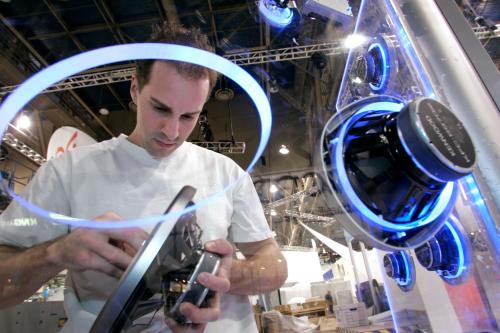After a good run, warning lights are flashing in the auto industry—and that’s not good for the broader manufacturing sector, for heartland metropolitan areas, or for President Trump.
Here’s the problem: after seven years of strong growth following the 2008 economic crisis and federal bailouts of both General Motors (GM) and Chrysler, auto sector output and employment growth have slowed markedly from record levels. Years of catch-up purchases by car buyers have finally plateaued. Likewise, automakers must economize to invest billions in developing the electric and self-driving cars of tomorrow.
And so the layoffs have begun. Last fall, Ford jolted the industry by revealing that its sales had peaked, while projecting a tough 2017. Then came the company’s April disclosure that it will need to slash $3 billion in costs to free up capital to invest in new technology. Soon after that came Ford’s announcement of as many as 20,000 layoffs worldwide, as well as word that GM had cut production at four U.S. assembly lines and would be laying off about 4,400 factory workers. Fiat Chrysler also laid off 1,300 workers at a Detroit assembly line.
By themselves, these announcements are not apocalyptic like the dire layoffs of 2008. Rather, the recent cuts mostly reflect the fundamentally cyclical nature of a huge consumer business. And yet, the present and future auto slow-down is a big deal because auto is critical to the manufacturing sector, which in turn looms large in regional and political narratives about whether the country is moving “in the right direction.”
Auto-related industries, after all, delivered about 40 percent of the nation’s manufacturing employment gains in the last two years, especially important given the slow growth of other production sectors in the face of a strong dollar.
Auto-related industries, after all, delivered about 40 percent of the nation’s manufacturing employment gains in the last two years, especially important given the slow growth of other production sectors in the face of a strong dollar. Focusing on just last year and the first quarter of this year, though, the data shows that auto represented fully 80 percent of U.S. manufacturing employment growth, even as auto hiring slowed significantly. Since then, the trend line has been blurry, but it’s unclear whether other industries—such as chemical manufacturing—are going to be able to pick up the slack from a likely auto-sector slowdown.

This is a problem. With auto growth slowing and employment growth potentially poised to turn negative, hundreds of metros, congressional districts, and states in the Midwest and Southeast could soon see the end of the solid to modest manufacturing sector momentum of recent years.
For a glimpse of what’s at stake, see here how manufacturing growth has turned negative in 39 of the nation’s 100 largest metropolitan areas in 15 months ending in March:

All those red dots suggest hazards are ahead: if layoffs accelerate in the auto sector, as they appear likely to, and no other manufacturing industries pick up the slack, scores of Midwestern and southern metropolitan areas and small towns—especially along Interstate 65 from the Great Lakes to Alabama—may have to deal with reduced help from what has been a steady source of decent employment, taxable sales, and economic momentum since the crisis. Such layoffs would be disappointing headwind as more metropolitan areas in the industrial Midwest, for example, continue to reduce their unemployment rates—including via the interesting ways tracked by my colleagues Alan Berube and Cecile Murray.
Which is why President Trump and congressional Republicans—along with regional economic development leaders from Kenosha to Wayne to Huntsville—should be worried about the direction of the auto and manufacturing sectors. To the extent that auto industries won’t likely be able to carry the mantle of a manufacturing revival in the next year, other production industries are going to have to step up to generate the working class hiring President Trump has promised.
To be sure, a number of new petrochemical plant openings along the Gulf Coast, made possible by cheap and plentiful natural gas, have allowed President Trump to tweet congratulations. And recent months have seen the economy add a modest number of manufacturing jobs—about 31,000 a month in the first quarter. However, those gains were later revised down and the economy actually lost 1,000 manufacturing jobs in May. In any event, none of this adds up to being remotely on track to deliver the “millions” of manufacturing jobs Trump promised to “bring back.”
All of which underscores the importance of the nation’s auto industry to the success of its manufacturing sector—and ultimately to President Trump’s core promise to “make America great again.” With fewer other manufacturing industries turning in substantial employment numbers, much more hangs on continued employment growth in the auto sector today than a decade ago. A true slump in the enormous auto sector—like the one that appears in the offing—could prompt new frustration in the battleground metros and congressional districts of Michigan, Ohio, Wisconsin, and Pennsylvania.
The author would like to thank Dustin Swonder for providing analytic and graphics help.
The Brookings Institution is committed to quality, independence, and impact.
We are supported by a diverse array of funders. In line with our values and policies, each Brookings publication represents the sole views of its author(s).







Commentary
Auto slowdown flashes caution lights for manufacturing employment — and Trump
June 19, 2017